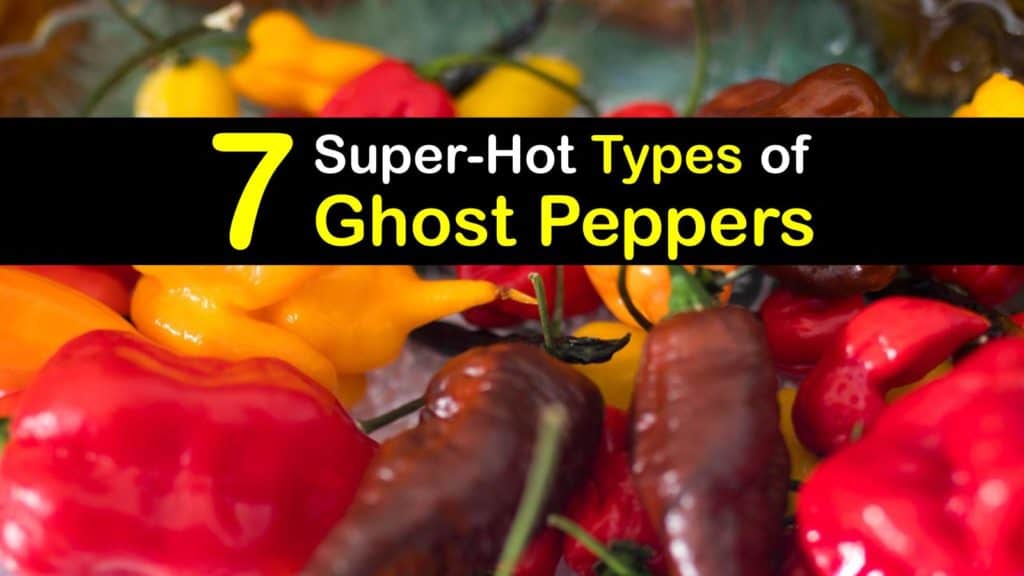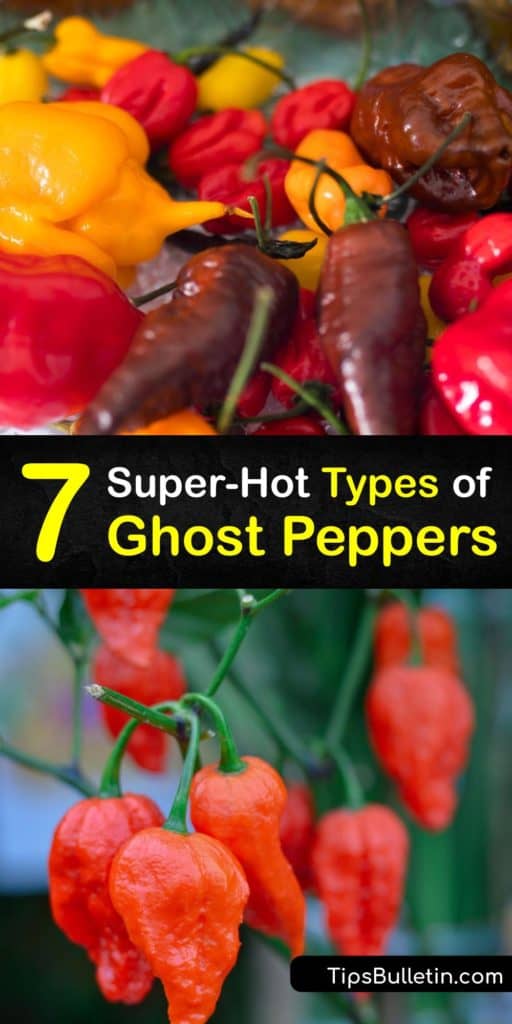It seems like the title for the world’s hottest pepper is constantly changing. Still, the Guinness World Records once dubbed the ghost pepper the hottest chilli pepper for several years. There are many different types of ghost peppers, with several of them still competing for the title of the spiciest pepper.
What is a ghost pepper, and how is the spiciness leveled determined? Ghost pepper varieties, as well as other peppers, measure their intense heat using Scoville heat units. These units give you an idea of how much heat there is in a single pepper.
Most of the hottest ghost pepper plants, called Capsicum chinensis, are high on the Scoville scale because they contain capsaicin. The highest concentrations of the capsaicin molecule are found in ghost pepper seeds.

What is a Ghost Pepper?
Peppers without it are sweet, like the bell pepper, and they get hotter as you work your way up. A jalapeno pepper is hotter than a bell pepper, hotter than a jalapeno is cayenne pepper, and even higher up the ladder are the habanero types of pepper.
Eventually, you get to such high Scoville heat units (SHU) that not even the toughest can handle it.
We understand that there are many hot peppers out there. What is the difference between sweet peppers like banana peppers with a fruity taste and a hotter type of chili pepper?
Chile pepper plants contain capsaicin so overwhelming that you only feel the extreme heat instead of the actual flavor of the pepper when you eat them. If you love spicy food, then finding a ghost chili is probably an exciting venture for you.
There are many types of ghost peppers. What are ghost peppers? Ghost pepper varieties come from Assam, India, and are identified by their wrinkly shape. The oldest known ghost pepper was found in a cave in Peru about 6,000 years ago.

There are also many different colors of ghost peppers. Red peppers are the most well-known and extremely spicy. Yellow is still hot but less intense. Orange is usually smaller and still packs a punch.
White has a smoother texture and notes of citrus. Brown is more pungent and sweet. Peach has the same heat as reds and a fruity aftertaste. Purple is the mildest of all ghost peppers. The question is, how hot can you handle?
Types of Ghost Peppers
There are several ghost pepper varieties, all under the name Bhut jolokia. Mexican cuisine has taken full advantage of the spice and turned them into a hot sauce that people love to pour over their meals.
Even though the current hottest pepper is the Carolina Reaper with over two million SHU, plenty of ghost peppers have unimaginable heat.
Many have the name Naga chili, which means serpent in Sanskrit and comes from Nagaland, India, where many of them grow naturally.
Trinidad Moruga Scorpion
Just under the Carolina Reaper pepper is the Trinidad Moruga Scorpion pepper. This pepper type is also sometimes called the Butch T chili. The Trinidad Moruga Scorpion has just over 2,000,000 SHU and is native to Trinidad and Tobago.
Take a single bite, and the burning takes hours to stop. Don’t let it fool you. Even though it’s slightly lower on the Scoville scale, it sets your mouth on fire almost the same as the world’s hottest pepper.
7 Pot Douglah
A pepper that is still intense at about 1,800,000 SHU is the 7 Pot Douglah pepper. This chili has a chocolate brown color and, although spicy, is known to have a fantastic flavor.
It is one of the few hot peppers that aren’t red. They are delicious fresh, powdered, and even dried if you can handle the heat.
Naga Viper
At 1,300,000 SHU, your mouth is still on fire with the Naga Viper. This ghost pepper is a hybrid of several different peppers. It is also scarce and cultivated in the United Kingdom. The Naga Viper wasn’t fully stabilized before its release, and pod variation is expected.
Naga Jolokia
Right around one million SHU is the Naga Jolokia pepper. Many people use this to make an extra-spicy ghost pepper sauce. It isn’t as hot as some other ghost pepper varieties and is much more manageable than others.
Heat the cold olive oil in a pan and then add the chopped peppers and onions when hot. Stir the pan contents until covered in oil. Add the diced tomatoes and cook for about ten minutes.
Stir in the vinegar, water, and salt and then simmer everything for 20 minutes and allow the flavors to meld. Transfer the ghost pepper mixture to a food processor or blender.
Process everything until smooth, and put it in an airtight container. Keep the sauce sealed and in the refrigerator until ready to use. For the best quality, allow the flavors of the sauce to develop for a couple of days before serving.
Naga Morich
These ghost pepper varieties come from Northeast India and Bangladesh. It is genetically different from other ghost peppers because it is slightly smaller with a more pimply and ribbed texture.
Bih Jolokia
This pepper is another known for its extreme heat and flavor. It surpasses 1,000,000 SHU and is extensively cultivated in Assan, Manipur, and Nagaland in India. When is the best time to harvest ghost peppers of the Bih Jolokia variety? The peppers start light green and eventually turn to a hot red color.
Nagabon
The Nagabon is a cross between a ghost pepper and Scotch Bonnet and is the pepper with the lowest heat level on this spicy list, topping out at about 750,000 SHU.
Because it is milder, it’s easier to appreciate the actual flavor of the pepper itself. Still, don’t let it trick you into thinking it’s mild. This pepper is still scorching hot.
Ghost Pepper Varieties and Their Features
Every variety of ghost pepper contains large and broad leaves that create a full canopy. The flowers are usually white and small in size, like the different kinds of jalapenos. Ghost pepper plants are some of the most productive crops, especially when grown under ideal conditions.
If growing ghost peppers at home, we recommend pruning them to protect them from soil-borne pathogens while they go through their ghost pepper plant stages.
They are slow growers, and you might have to sow seeds indoors to get a head start on the growing season. With suitable soil, fertilizer, and light, some plants reach three feet tall in a single growing season.
What is a ghost pepper, and why don’t you eat them more? You have to be cautious when working with ghost peppers, regardless of the cultivar. These peppers held the world record from 2007 to 2011.
Though there are now hotter peppers available, that doesn’t mean they shouldn’t be taken seriously. Many people assume they can handle the heat, but you’d be surprised at how spicy they are.
Ghost peppers come in different colors and heat units, but they are still very similar. If you are someone who loves the burning sensation of spicy food, growing ghost peppers at home is a fun way to have control over your food.
They are also easy to preserve and ideal to have on hand when you’re looking for an added kick to your favorite meals.

If learning about the different types of ghost peppers has made you crave spicy food, share these ghost pepper varieties on Facebook and Pinterest.